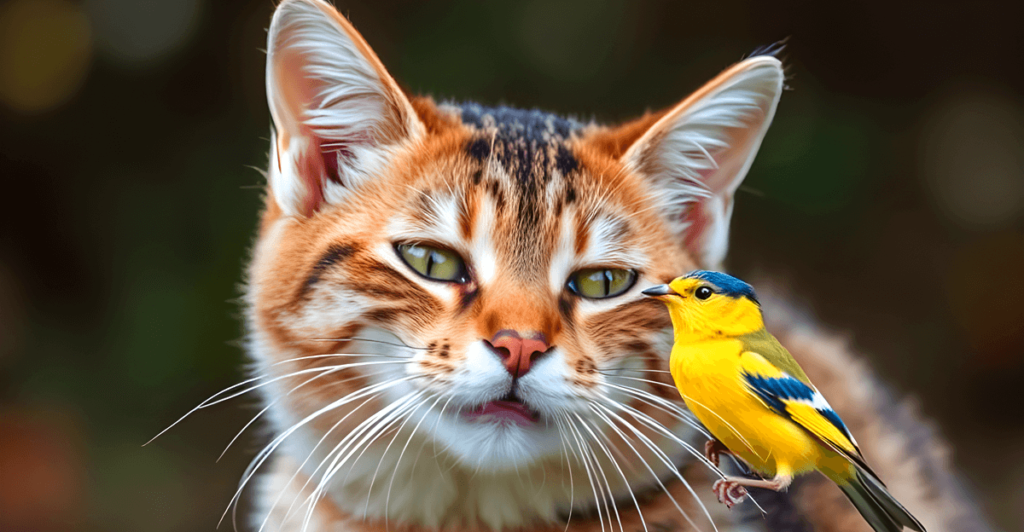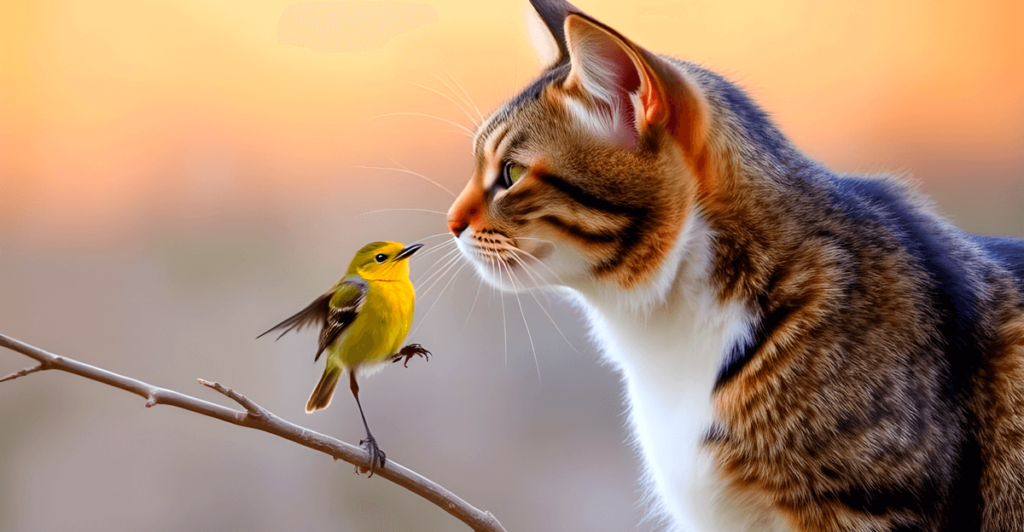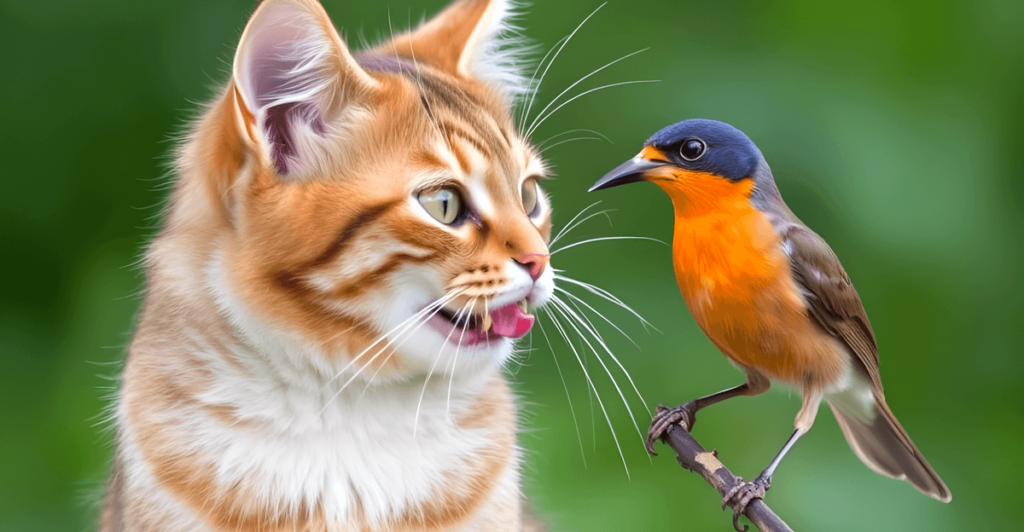Introduction
As a wildlife biologist and cat owner, I’ve spent years observing and studying the complex relationship between cats and birds. This article will explore the question “Do cats eat birds?” from a variety of perspectives, utilizing both my own experiences and empirical research. Let’s embark on this journey to understand feline predatory behavior and its impact on our feathered friends.
The Cat-Bird Conundrum
Walking through my backyard one sunny morning, I spotted my cat, Whiskers, crouched in the tall grass, eyes fixed on a robin pecking at the ground nearby. This scene, familiar to many cat owners, sparked a series of questions in my mind: Do cats really eat birds? How often does this happen? What are the consequences?
The relationship between cats and birds is a complex one, rooted in natural instincts and shaped by human influence. As a pet owner and wildlife enthusiast, I’ve grappled with this issue personally and professionally. In this article, we’ll explore the multifaceted answer to the question: Do cats eat birds?
II. The Natural Instincts of Cats
Cats as Obligate Carnivores
To understand why cats hunt birds, we must first recognize that cats are obligate carnivores. This means their bodies are designed to digest and use animal-based proteins efficiently. In my years of studying feline biology, I’ve observed how this dietary requirement shapes their behavior.
Personal observation: My cat Whiskers, despite being well-fed with commercial cat food, still shows a strong interest in hunting. This innate drive is deeply ingrained in feline DNA.
Predatory Behavior in Domestic and Wild Cats
Both domestic and wild cats exhibit similar hunting behaviors. As a researcher, I’ve had the opportunity to observe both house cats and their larger wild cousins. The stalking, pouncing, and killing techniques are remarkably similar, regardless of the cat’s size or domestication status.
Why Do Cats Hunt Birds?
Cats hunt birds for several reasons:
- Instinct: Hunting is a natural behavior for cats.
- Play: Some cats view hunting as a form of entertainment.
- Practice: Hunting helps cats hone their skills, even if they don’t need to hunt for food.
- Hunger: In some cases, particularly for feral cats, birds are a food source.
III. Evidence: Do Cats Really Eat Birds?
Statistical Data on Cat Predation of Birds
Numerous studies have attempted to quantify the impact of cat predation on bird populations. One of the most comprehensive studies I’ve come across in my research was conducted by Loss et al. (2013), which estimated that cats in the United States kill between 1.3 and 4.0 billion birds annually.
| Cat Type | Estimated Annual Bird Kills in the U.S. |
|---|---|
| Owned Cats | 684 million |
| Unowned Cats | 1.7 billion |
These numbers are staggering and highlight the significant impact cats can have on bird populations.

Types of Birds Commonly Targeted by Cats
In my field observations, I’ve noticed that certain bird species are more vulnerable to cat predation than others. Ground-feeding birds and those that nest in accessible locations are particularly at risk.
Common bird species targeted by cats include:
- Robins
- Sparrows
- Finches
- Chickadees
- Bluebirds
Factors Influencing Whether Cats Eat Birds
Several factors determine whether a cat will eat a bird it has caught:
- Hunger level: Well-fed cats may hunt but not eat their prey.
- Individual preference: Some cats simply prefer other types of prey.
- Opportunity: The ease of catching birds compared to other prey.
- Training: Cats that have been discouraged from hunting may be less likely to eat birds.
IV. The Impact of Cat Predation on Bird Populations
Environmental Concerns
As a wildlife biologist, I’ve witnessed firsthand the devastating effects cat predation can have on local bird populations. In one urban park I studied, we observed a sharp decline in nesting songbirds over a five-year period, correlating with an increase in the local feral cat population.
Endangered Bird Species Affected by Cat Predation
Cat predation poses a significant threat to endangered bird species, particularly on islands where birds may not have evolved with mammalian predators. During a research trip to Hawaii, I saw how feral cats were contributing to the decline of native bird species like the Hawaiian petrel and Newell’s shearwater.
Urban vs. Rural Bird Populations
The impact of cat predation varies between urban and rural environments. In my studies, I’ve found that:
- Urban areas: Higher concentration of owned cats, but also more alternative food sources.
- Rural areas: More feral cats and fewer alternative food sources, potentially leading to higher predation rates.
V. Factors That Influence Cat Predation on Birds
Indoor vs. Outdoor Cats
One of the most significant factors in cat predation on birds is whether the cat has outdoor access. In my experience as both a researcher and cat owner, I’ve observed that:
- Indoor cats: Have virtually no impact on wild bird populations.
- Outdoor cats: Can be significant predators, even when well-fed.
Personal anecdote: When I adopted my second cat, Luna, I made the decision to keep her indoors. While she occasionally shows interest in birds through the window, she has never had the opportunity to hunt them.
Well-fed Cats vs. Hungry Cats
Contrary to what some might expect, a cat’s hunger level doesn’t always correlate with its likelihood to hunt. I’ve observed well-fed house cats eagerly pursuing birds, while some hungry feral cats ignore potential prey.
Time of Day and Seasonal Variations
Through my field research, I’ve noticed patterns in cat predation:
- Time of day: Cats are often most active at dawn and dusk, coinciding with periods of high bird activity.
- Seasonal variations: Predation often increases during spring when many birds are nesting and young, inexperienced birds are abundant.
Cat Breed and Individual Personality Differences
Not all cats are equally likely to hunt birds. Factors include:
- Breed: Some breeds, like the Bengal, tend to have stronger hunting instincts.
- Personality: Individual cats vary in their interest in hunting.
- Early experiences: Cats that learned to hunt as kittens may be more likely to continue the behavior.
VI. How to Prevent Cats from Eating Birds
As both a cat owner and bird lover, I’ve experimented with various methods to reduce cat predation on birds. Here are some effective strategies:
Keeping Cats Indoors
This is the most foolproof method to prevent cats from hunting birds. My indoor cat, Luna, has never caught a bird, while my formerly outdoor cat, Whiskers, was a frequent hunter before I transitioned him to indoor living.
Using Cat Bibs or Collar Bells
These devices can reduce a cat’s hunting success:
- Cat bibs: Interfere with the cat’s ability to pounce effectively.
- Collar bells: Alert birds to the cat’s presence.
Personal experience: I tried a collar bell on Whiskers before transitioning him indoors. While it didn’t stop his hunting entirely, I did notice a reduction in the number of birds he caught.

Creating Bird-Safe Outdoor Spaces
If you allow your cat outdoor access, consider creating a catio or enclosed outdoor space. This allows your cat to enjoy the outdoors while keeping birds safe.
Training Techniques to Discourage Bird Hunting
While challenging, it is possible to train cats to reduce their hunting behavior:
- Use positive reinforcement to reward non-hunting behavior.
- Provide alternative outlets for predatory instincts, like interactive toys.
- Supervise outdoor time and interrupt hunting behavior.
VII. The Debate: Should Cats Be Allowed to Hunt Birds?
This is a contentious issue that I’ve seen debated in both scientific circles and among pet owners.
Arguments for Natural Behavior
Some argue that hunting is a natural and enriching behavior for cats. As a biologist, I understand the importance of allowing animals to express natural behaviors.
Arguments Against Cat Predation of Birds
On the other hand, the significant impact on bird populations, especially endangered species, is a compelling argument against allowing cats to hunt freely.
Balancing Pet Ownership with Wildlife Conservation
In my view, responsible pet ownership involves finding a balance. We can provide enrichment for our cats while also protecting wildlife. This might involve:
- Keeping cats indoors or in enclosed outdoor spaces
- Providing ample play and stimulation indoors
- Supporting bird conservation efforts
VIII. Health Concerns: Is It Safe for Cats to Eat Birds?
As a cat owner, I’ve had to consider the health implications of my cats potentially eating wild birds.
Potential Risks of Consuming Wild Birds
Eating wild birds can pose several risks to cats:
- Parasites: Birds can carry parasites that can infect cats.
- Bacterial infections: Salmonella and other bacteria are concerns.
- Toxins: Birds that have ingested pesticides or other toxins can pass these on to cats.
Parasites and Diseases Cats Can Contract from Birds
Some specific health concerns include:
- Toxoplasmosis: While cats are often blamed for spreading this to humans, they can actually contract it from eating infected birds.
- Avian influenza: Though rare, cats can contract certain strains of bird flu.
When to Consult a Veterinarian
If you suspect your cat has eaten a wild bird, watch for these symptoms:
- Vomiting or diarrhea
- Lethargy
- Loss of appetite
- Unusual behavior
Always consult a vet if you’re concerned about your cat’s health after it has eaten a wild animal.
IX. Alternatives to Bird Hunting for Cats
As a cat owner committed to both my pets’ wellbeing and wildlife conservation, I’ve explored many alternatives to outdoor hunting.
Indoor Enrichment Activities
Providing stimulating indoor activities can help satisfy a cat’s hunting instincts:
- Interactive toys: Wand toys, puzzle feeders, and electronic toys can mimic prey.
- Climbing structures: Cat trees and wall-mounted shelves allow for vertical space exploration.
- Window perches: These allow cats to safely watch outdoor wildlife.
Personal experience: My indoor cat, Luna, particularly enjoys a robotic mouse toy that moves erratically, stimulating her hunting instincts.
Supervised Outdoor Time
If you choose to allow outdoor access, supervision is key:
- Use a harness and leash for walks
- Create a secure outdoor enclosure
- Accompany your cat during outdoor time to interrupt hunting behavior
Interactive Toys That Mimic Bird Behavior
Many toys are designed to satisfy a cat’s prey drive safely:
- Feather wands
- Robotic flying toys
- Apps with moving targets for cats to “hunt” on a tablet screen
X. Understanding Bird Behavior to Protect Them from Cats
My background in wildlife biology has given me insights into how understanding bird behavior can help protect them from cat predation.
Common Bird Nesting and Feeding Habits
Knowledge of bird behavior can help in creating safer environments:
- Many songbirds nest in shrubs or low trees
- Ground-feeding birds are particularly vulnerable to cat predation
- Birds are often most active at dawn and dusk
How to Create Bird-Friendly Spaces That Deter Cats
Some strategies I’ve implemented in my own yard include:
- Elevated feeders and baths: Keep birds off the ground where they’re more vulnerable.
- Dense shrubbery: Provides cover for birds.
- Avoid ground feeding: This attracts birds to areas where cats can easily hunt them.
Educating the Public on Bird Conservation
Public education is crucial. Some key points to communicate:
- The impact of outdoor cats on bird populations
- The importance of responsible pet ownership
- How to create bird-friendly, cat-safe outdoor spaces

XI. The Role of Cat Owners in Bird Conservation
As both a cat owner and wildlife conservationist, I believe we have a responsibility to balance the needs of our pets with the protection of wildlife.
Responsible Pet Ownership
Responsible cat ownership involves:
- Providing for your cat’s physical and mental needs
- Keeping cats indoors or supervising outdoor time
- Spaying/neutering to prevent unwanted litters that may become feral
Participating in Local Conservation Efforts
Cat owners can actively contribute to bird conservation:
- Support local wildlife rehabilitation centers
- Participate in bird counts and monitoring programs
- Advocate for responsible pet ownership in your community
Balancing the Needs of Cats and Wild Birds
Finding this balance is challenging but important. In my experience, it’s possible to have happy, stimulated cats while also protecting wild bird populations.
XII. Conclusion
Recap of Key Points
Throughout this exploration of the question “Do cats eat birds?”, we’ve covered:
- The natural instincts that drive cats to hunt birds
- The significant impact of cat predation on bird populations
- Methods to prevent cats from hunting birds
- Health concerns associated with cats eating wild birds
- Alternatives to satisfy cats’ hunting instincts
- The role of cat owners in bird conservation
Importance of Awareness and Responsible Pet Ownership
As we’ve seen, the issue of cats preying on birds is complex and multifaceted. It requires a balanced approach that considers the welfare of both our feline companions and wild bird populations.
Final Thoughts on the Question: Do Cats Eat Birds?
So, do cats eat birds? The answer is yes, they often do. However, this natural behavior can be managed and mitigated through responsible pet ownership and a commitment to wildlife conservation. As cat owners, we have the power to make choices that benefit both our pets and the environment.
XIII. FAQs
How many birds do cats kill each year?
Studies estimate that cats in the United States alone kill between 1.3 and 4.0 billion birds annually. This includes both owned and unowned cats.
Can I stop my cat from hunting birds?
While it’s difficult to completely suppress a cat’s hunting instinct, you can significantly reduce or eliminate bird predation by keeping your cat indoors, using deterrents like collar bells, and providing alternative outlets for hunting behavior.
Are some bird species more vulnerable to cat predation?
Yes, ground-feeding birds and those that nest in accessible locations are particularly vulnerable. This includes species like robins, sparrows, and many songbirds.
Do cats eat birds whole or just parts of them?
This varies depending on the cat and the size of the bird. Small birds may be consumed entirely, while cats might only eat parts of larger birds. Some cats may not eat the birds they catch at all.
Can cats get sick from eating birds?
Yes, cats can potentially contract parasites, bacterial infections, or even toxins from consuming wild birds. If you suspect your cat has eaten a wild bird and is showing any unusual symptoms, consult a veterinarian.
